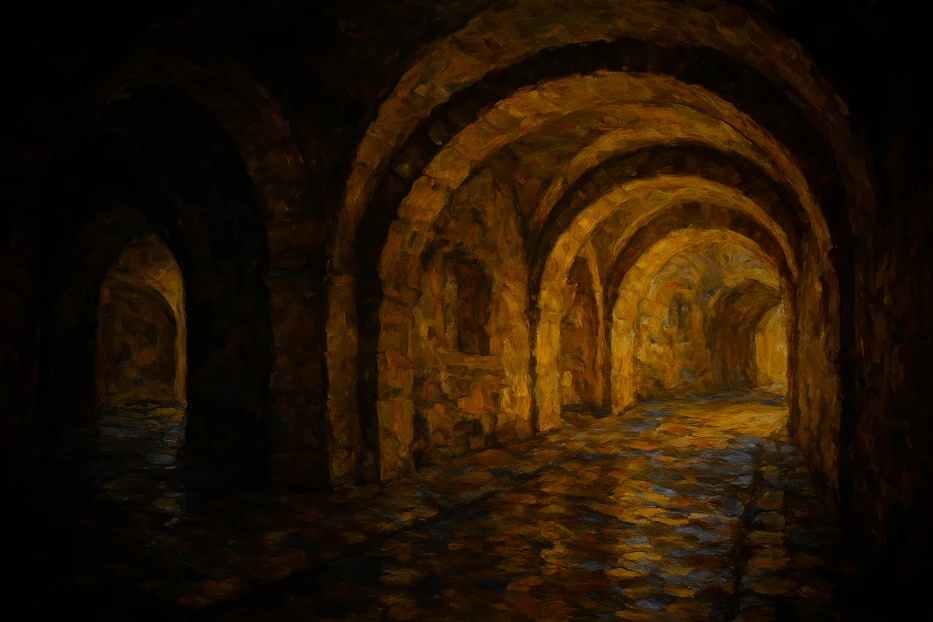Edinburgh’s mysterious places reveal a city with two faces.
By day, the Scottish capital dazzles with elegant Georgian avenues, cobbled Old Town wynds, and the commanding silhouette of its castle. By night — or when you duck beneath its streets — another city emerges. Vaulted chambers, misty graveyards, witch memorials, and enigmatic tunnels reveal centuries of intrigue and fear.
For the curious traveler, Edinburgh offers more than museums and whisky bars — it offers mystery. This guide uncovers the city’s most fascinating and eerie corners, blending rich history with practical tips for your journey. Check GetYourGuide for availability, and DiscoverCars if you’d like to explore the city and beyond by car.
Table of Contents
Mary King’s Close — A Sealed Street Beneath the City
Mary King’s Close is among Edinburgh’s mysterious places that draw thousands of visitors each year, offering tours that combine history and spine-chilling tales.
Underneath the Royal Mile lies Mary King’s Close, a 17th-century street entombed when the Royal Exchange was constructed above in the 1750s. Opened to the public in 2003, it has become one of Edinburgh’s most intriguing attractions.
Why it’s mysterious: The Close has inspired countless ghost stories, from plague victims sealed away to the tale of “Annie,” a child spirit said to haunt its rooms. While historians note these are legends, the dimly lit passageways and preserved homes leave an undeniable chill.
The Edinburgh Vaults — Secrets Under South Bridge
The South Bridge Vaults, built in the 1780s, are one of the most intriguing of Edinburgh’s mysterious places. Originally used as workshops, they later became notorious slum dwellings and sites of illicit trade. Sealed for nearly two centuries, the vaults were rediscovered in the 1980s and are now among the city’s spookiest attractions.
Why it’s mysterious: Dark, damp chambers echo with tales of body snatchers and desperate families. Ghostly reports range from footsteps to sudden icy drafts.
Greyfriars Kirkyard — Restless Spirits Among the Stones
Greyfriars is more than a picturesque graveyard; it’s a place where history and legend converge. The Mackenzie Mausoleum is linked to the infamous “Mackenzie Poltergeist,” blamed for scratches, bruises, and fainting fits among ghost tour guests.
Why it’s mysterious: It’s home to haunting tales, but also the touching story of Greyfriars Bobby, the loyal Skye terrier who guarded his master’s grave for 14 years.
The Lost Close — A Hidden Chapter Beneath Parliament Square
Less famous but equally evocative, The Lost Close is a rediscovered network beneath Parliament Square. It served civic functions in centuries past and now hosts storytelling, tastings, and cultural experiences.
Why it’s mysterious: With its blend of archaeology and immersive design, The Lost Close feels like stepping through layers of forgotten Edinburgh.
Gilmerton Cove — Edinburgh’s Subterranean Puzzle
From hidden chambers in Gilmerton Cove to the cryptic carvings of Rosslyn Chapel, Edinburgh’s mysterious places extend beyond the city centre, rewarding those who explore them with stories both eerie and fascinating.
Three miles from the city centre lies Gilmerton Cove, a labyrinth hand-carved into sandstone. Historians have never agreed on its purpose: a refuge for Covenanters, a smugglers’ den, or a meeting place for Freemasons.
Why it’s mysterious: Ground-penetrating radar shows the tunnels extend further than accessible today, suggesting hidden passages still await discovery.
The Witches’ Well — A Quiet Memorial Near the Castle
On Castle Esplanade, a small bronze fountain marks a grim chapter. Between the late 1400s and early 1700s, more than 300 people accused of witchcraft were executed in Edinburgh, many burned at the stake nearby.
Why it’s mysterious: Artist Phoebe Anna Traquair’s relief depicts foxglove (a healing herb), a serpent, and a face, symbolizing the fine line between good and evil.
Tolbooth Tavern — Spirits in a Pub with a Past
The Canongate Tolbooth, built in 1591, once served as a council house, courthouse, and prison. Today, it’s home to the Tolbooth Tavern, where history lingers in low ceilings and creaking timbers.
Why it’s mysterious: Stories of unexplained footsteps and ghostly apparitions add atmosphere to a pint of local ale.
Rosslyn Chapel — Symbols Carved in Stone
Just seven miles south of the city, Rosslyn Chapel is famed for its dense and mysterious carvings. Built in 1446, the chapel’s walls are filled with Green Men, angelic musicians, and intricate patterns that have sparked endless speculation.
Linked (sometimes fancifully) to the Knights Templar and the Holy Grail, Rosslyn draws visitors from across the globe.
Why it’s mysterious: Few sites combine such craftsmanship with such mystery. Even scholars admit much of its symbolism remains open to interpretation.
Arthur’s Seat & The Mystery of the Coffins
Holyrood Park’s volcanic peak offers some of the city’s best views — but also a riddle. In 1836, 17 miniature coffins containing tiny dressed figures were discovered in a cave on Arthur’s Seat.
Why it’s mysterious: Scholars have debated their purpose for nearly two centuries. Were they symbolic burials for murder victims, talismans, or part of a ritual? No answer has ever been agreed upon.
Where they are now: Only eight of the original coffins survive, and they’re on permanent display at the National Museum of Scotland on Chambers Street. Admission is free, so you can hike Arthur’s Seat in the morning and then see the artifacts yourself in the afternoon — a perfect pairing of outdoor mystery and museum discovery.
Beyond Edinburgh — Mystery by Sea
If Edinburgh awakens your appetite for legend, consider extending your journey. Ferries link the city to islands steeped in ancient myth, from Orkney’s standing stones to the Hebrides’ Viking past.
Travel tip: With Direct Ferries, you can explore ferry routes and book tickets across Scotland’s waters, seamlessly adding maritime adventure to your journey.


